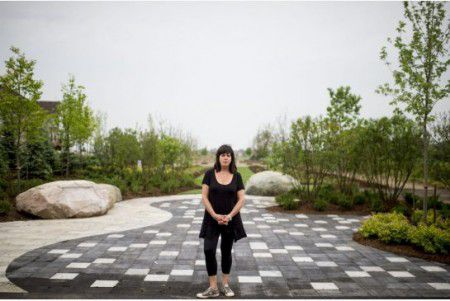Special to the Star | Dan O’Reilly
 on July 05, 2013
on July 05, 2013
This story has been updated from an earlier version
A ceremony set for July 7 will dedicate a garden in a newly developed section of east Brampton to remember the 109 people who died there in the GTA’s largest air crash 43 years ago.
On July 5, 1970, Air Canada Flight 621 was en route from Montreal to Los Angeles when it plunged into what was then the farming community of Toronto Gore. Located north east of Pearson Airport, the crash claimed the lives of all passengers and crew.
Financed by the seven developers who are building the River’s Edge community, the Flight 621 Memorial Garden is set in the West Humber River Valley which bisects the new development. It has been constructed by Bruce Wilson Landscaping, which just recently completed the final touches. The dedication ceremony is planned for 10:30 a.m. tomorrow at the crash site, adjacent to DeGrey Drive.
“We wanted to create a quiet, beautiful and contemplative space that hopefully will provide some solace, (to the family members) fully understanding the pain will never go away,” says Michael Toccalino, associate with Toronto-based Nak Design Strategies. Design work started in 2006.
The primary element is 109 polished, light pink granite markers to commemorate each person who was on board Flight 621 and set in a grid of black granite chip paving.
A plaque, engraved with the names of all who perished, has been permanently mounted on large granite boulder that was unearthed during the development, says Toccalino.
Mass lilac plantings, a favourite of some of the crash victims, have been planted around the memorial paving “in tribute to the rural heritage of the area” while the limits of the one-acre cemetery are marked with 10 upright granite markers.
The garden is a cemetery and has been ruled as such by the Ontario Registrar of Cemeteries, says Diarmuid Horgan, president of Brampton-based Candevcon Limited, the engineering and group consultant for the developers which coordinated and spearheaded the project.
D.R. Archaeologists, based in London, Ont., was the firm charged with the delicate and painstaking task of searching for remaining bone fragments and interring soil from the crash site into the garden, he says.
“We had to be sensitive about this (the garden) and make sure it was done with a certain amount of conscience.”
“We had to be sensitive about this (the garden) and make sure it was done with a certain amount of conscience,” says Horgan, in an overview of the lengthy and laborious process required to move the garden from concept to completion.
An agreement among the various developers had to be reached and several work plans implemented. Although legal approval from the victims’ relatives was not required, Horgan felt it was important they be informed of the project.
“Not one of them objected to what we were doing.”
Contacting them initially, though, was an intensive undertaking. Ads were placed in Montreal-area newspapers where many of the passengers lived, say Horgan. He instructed his staff to pour through old newspapers and archival material.
In that search, the engineering firm was assisted by Lynda Fishman, whose life was changed forever by the accident. The crash victims included her 39-year-old mother Rita Weinberg, and her sisters Carla, 11, and Wendy, 8. They were on their way to a planned month-long holiday with her aunt who lived in Los Angeles.
“I had gone down a week earlier,” says Fishman, author of Repairing Rainbows, which documents how she “dealt with and continues to deal” with their loss.
Just age 13 at the time, she vividly remembers the very early morning telephone call from her father in Montreal relaying the news about the accident.
“Even now if I get a telephone call at night it startles me.”
Just as vivid in her mind is the “devastating” experience she suffered after returning home the same day and seeing the front page of the Montreal Star. It carried a photograph of a doll among the debris. The doll had belonged to her younger sister, Wendy. “I just knew it was hers.”
Toronto Star photographer Boris Spremo took the photo, to which Fishman bought the rights and used on the cover of her book.
A retired summer day camp owner and director, a trained clinical social worker, author and inspirational speaker, Fishman is relieved and grateful for the on-site memorial. (A dedication monument was erected several years ago in Toronto’s Mount Pleasant Cemetery.)
“It (the garden) should have been built years ago. It’s disgusting and heartbreaking the remains were left to rot in a field for so long.”
A few years ago after completing her book, Fishman found the “courage” to contact the City of Brampton to see if it might consider an on-site memorial. That’s when she learned a project, by the private development group, was underway.
Officials there put her in contact with Candevcon and Fishman was invited to meet with the “compassionate and caring planners because they wanted input from family members.”
Besides providing that input, she also used the Internet and networking connections to invite the victims’ relatives to an inaugural ceremony in July 2010 near the crash site where plans for the garden were officially unveiled. Several spoke of their pain and loss.
Another speaker was Brampton resident Lynne Genova, who also met with the engineering firm and provided input for the design. Her family’s former sheep farm was less than a kilometre from the crash site.
“I can still hear the sound of the explosion and my mother screaming,” says Genova, who like Fishman, was 13 at the time.
Yet, when she returned to school that September, “there was no talk about the crash,” says Genova, who for the past several years has been working and speaking at events to ensure the story of the crash did not fade from public memory.
For as long as she “is physically and mentally able,” Genova says she will visit the memorial garden on the crash anniversary for the rest of her life.
Memorial Garden at heart of community
The Flight 621 Memorial Garden will be an integral component of the River’s Edge community, which is comprised of east and west quadrants overlooking the West Humber River Valley.
A trail will extend from a recently built park on the east side of the development down to the park and then cross a pedestrian bridge over the Humber River to link with the west half, says Diarmuid Horgan, president of Candevcon Limited, the consulting firm for the developers. A school will be built in the west quadrant not far from the trail.
Located in the Castlemore area of Brampton, the 560-lot community was developed by a consortium of seven firms who financed the design and constructed the memorial garden, says Horgan.
They include Port Mark Investments Ltd.; Mcveanone Developments Limited; Opus Homes (River’s Edge) Inc.; 2073737 Ontario Inc/2073740 Ontario Inc.; Trinison Management Corporation; Daniels LR Corporation; and the Calo-Bellissimo Group.
There are two blocks which remain undeveloped. The Calo-Bellissimo Group has not yet sold its 40 lots and there is no timeline on when that might happen. The Daniels Corporation also has plans to build 130 freehold condominium units, says Horgan.

